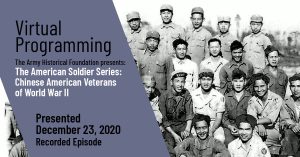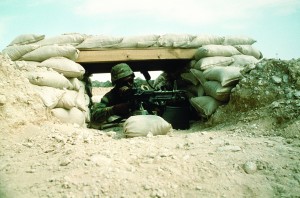Written By: Andrew E. Woods

In his 1935 book Memories of Peace and War, BG Beaumont B. Buck, who commanded the 2d Infantry Brigade, 1st Division, in the battle of Soissons, July 1918, wrote, “After the battle is launched, battalion, company, platoon and section commanders are the men who must carry out the purpose of the higher command. Decision! Action! Instantaneous on the part of the commander on the spot.”
In “The Operations of the 28th Infantry in the Aisne-Marne Offensive,” MAJ Clarence R. Huebner, who later commanded the 1st Infantry Division in World War II, agreed. He wrote, “The infantry attack has as its basis the fighting spirit and aggressiveness of its officers…It is the duty of all leaders to stimulate and cultivate fearless, intelligent leading on their part, and individual initiative on the part of the individual soldier.” These leaders knew that good junior officers are critical.
They must lead and direct small units, be ready to fill greater roles, and have the spirit to act immediately. Exemplary of the junior officers they had in mind when they wrote was 2LT Samuel I. Parker, whose tenacious combat leadership throughout the war made him one of the most highly decorated officers in the Army at the time.
Born in 1891, Samuel Iredell “Si” Parker attended the University of North Carolina at Chapel Hill. He worked summers at a ranch in Kansas where he learned the quick draw and how to shoot from the hip, a skill, Parker held, that saved his life many times.
When the United States entered World War I on 6 April 1917, Parker volunteered immediately. He went to the officers’ training camp at Fort Oglethorpe, Georgia, and shipped overseas to France in September 1917. He trained with the British Fifth Army near the Somme River and, on 21 November 1917, he joined Company K, 3d Battalion, 28th Infantry Regiment, 1st Division, in training at Gondrecourt, France. By March 1918, he led his unit in defending the trenches of the Ansauville Sector.

The first American offensive of World War I was at Cantigny on 28 May 1918. The 28th Infantry was the assault regiment of the 1st Division’s attack. Parker led Company K’s 1st Platoon on the regiment’s left flank. In a letter to his brother, Parker wrote, “As a point of personal pride, I want remembered that I was in the first wave of the first attack that the United States Army made against Germany, and the operation was entirely successful. I started the scrap with 35 men and I estimate that my platoon can easily account for 350 of the enemy. I hope to cause them much more grief when I have another opportunity.” Leading a section of twelve men, Parker and a sergeant charged a trench. A burly German soldier threw a grenade at them, which did not explode. After the sergeant killed the German, Parker and his men continued the advance, taking fifteen German soldiers prisoner.
After Cantigny was captured, Parker’s platoon held an outpost north of the town while his battalion dug in. Over the next three days, the Germans failed in repeated counterattacks to recapture the town. Parker wrote, “I have never seen such a spirit… at the first check of my platoon I found that I had only eleven men left. But I have taken these eleven men and built another platoon. The spirit of my old platoon is still living. But it seems that no one will ever be able to take the places of some of those good soldiers that were lost.”
Six weeks later, Parker had his opportunity to cause the enemy more grief as he and his platoon took on the mission of a regiment in combat. The Battle of Soissons, part of the Aisne-Marne campaign, opened on 18 July 1918. Parker’s platoon was again on the left flank of the 1st Division. The 3d Battalion, initially in support, moved out on a predetermined schedule and directly into a German artillery barrage that landed behind the 2d Battalion. About a quarter of the men were casualties. Despite this, the first and second objectives were taken that morning.
The Missy Ravine proved an obstacle to the French 153d Division on the 1st Division’s left. German 77mm guns and machine guns in positions just north of the 1st Division stopped the French. The attack could not progress unless someone took these strong points. Two 28th Infantry battalion commanders, MAJ Clarence R. Huebner and MAJ Willis J. Tack, launched attacks beyond the 1st Division’s left boundary. Company K, as part of MAJ Tack’s 3d Battalion, took le Mont d’Arly, helping to clear the path for Company M and the Regimental Headquarters. Company K then continued the attack to the east, fighting their way across the ravine to the quarries on the high ground northeast of Breuil. Parker led the way, adding some leaderless French colonial troops to his depleted platoon.

Parker’s platoon stormed a machine gun nest in the quarry on the northernmost part of the 28th Infantry’s line, capturing forty men and six machine guns. In this action, Parker credited a former North Carolina classmate with saving his life. Parker’s buddy led three privates of Company I in charging and destroying an enemy machine gun positioned to sweep the quarry. Wounded and using a rifle as a crutch, the private stumbled and crawled back to a first aid station. This soldier was PVT Samuel J. Ervin, Jr., later to become a U.S. Senator for North Carolina and chairman of the Senate committee investigating the Watergate affair in 1973.
Parker held his position at the quarry until the Americans there were relieved by a French regiment. On the morning of 19 July, the 1st Division continued the attack. Shortly after jump off, and west of the Paris-Soissons highway (Route No. 2), MAJ Tack was wounded. Enfilade fire from an enemy strong point on the left annihilated Company M. Losses were so great that the 2d and 3d Battalions were reorganized as a rifle company under the command of MAJ Huebner. They were down to 120 riflemen, four machine guns, and two officers, Huebner and Parker. Stragglers and slightly wounded men were gathered into an ad hoc machine gun platoon with captured German guns. Parker led the advance wave toward Route 2 when Huebner was wounded.
Parker came back to see Huebner laid out on his back with a shrapnel wound in his forehead. Before he lost consciousness, MAJ Huebner transferred command to Parker saying, “Take my maps and carry on.” Parker returned to the front wave in the attack to the highway. Shortly afterwards, a high explosive shell blasted him into the air and wounded his right foot. Parker took off his shoe and bound his own wound, refusing evacuation. Unable to cross the highway, the men took cover along its west bank and a nearby ditch. Parker still had the 28th Regiment’s mission to perform. BG Charles P. Summerall at 1st Division headquarters issued an order for the 28th Infantry to attack from Route 2 to the Ploisy Ravine the evening of 19 July. COL Conrad S. Babcock, commanding the 28th Infantry, had concerns with this order. The regiment had not taken the highway yet.

There was still a 1,000 meter gap between his troops and the French to the north. The 1st Battalion, released from division reserve, was back at Breuil. The regiment had no battalions on the front, only Parker and 120 riflemen on the west bank of Route 2. Summerall told COL Babcock to attack from there.
Parker led the attack on Ploisy, crawling because of his painful wound. He did not leave until his composite command consolidated at Ploisy that night, when other officers reached the front.
On the morning of 20 July, Parker made his painful way to an aid station near the Ploisy ravine. On 21 July, with BG Buck leading the attack in person, the 2d Brigade captured Berzy le Sec from the decimated remnants of four German divisions. The enemy then decided to evacuate the Marne salient, beginning a fighting withdrawal that continued for the rest of the war. After recovering, Parker returned to Company K, and was pleased a few weeks later to welcome MAJ Huebner back to the 28th Infantry. Their war was not over yet. On 5 October in the Argonne forest, Parker rushed a German machine gun and killed the gunner with his pistol.
At Exermont, he was almost surrounded by the enemy, but with an officer and two squads of infantrymen, he inflicted heavy losses on the Germans. Parker received the Distinguished Service Cross for this battle. “I want it clearly understood,” said Parker, “that I have never killed a man except in defense of my own life.” After World War I, Parker worked in the textile manufacturing business at the Ciba Company in Atlanta, Georgia, and served as a Reserve officer from 1923 to 1939. In 1936 he was awarded the Medal of Honor for his leadership at Soisson.
President Franklin D. Roosevelt personally presented the medal at the White House. Samuel Parker became the first officer to receive the Medal of Honor, Distinguished Service Cross, Silver Star, and Purple Heart. Parker was recalled to service in World War II as a major and instructed thousands of officer candidates at the Infantry School at Fort Benning, Georgia. He retired at the end of World War II with the rank of lieutenant colonel, adding the Legion of Merit to his long list of awards. Samuel Iredell Parker died at Walter Reed Army Medical Center in Washington, DC, on 1 December 1975. He is buried at Oakwood Cemetery, Concord, North Carolina. Small unit commanders with the spirit and gallantry of Samuel Parker were essential to the success of the 1st Division and the American Expeditionary Forces in World War I. This heroic leader inspired initiative in his platoon, and in the next generation of soldiers.






